“A brief discussion of some key opportunities to increase year-round wildlife habitat quality and maximize outdoor opportunities between deer season and turkey season.”
By Evan Wheeler, GWF Private Lands Biologist
11 February 2021
White-tailed deer season has to come to an end, wild turkey season has yet to begin, it is still cold outside on most days, and many Georgia residents are not getting outside much. Instead of waiting for those sunny spring days, consider taking advantage of some of the numerous opportunities to get out and enjoy the great outdoors for some recreation and contribute to wildlife habitat enhancement. For example, small game season is open through February 28th, wild pigs are always in season on private lands, the crappie are biting, and this is a great time to apply prescribed fire and plan other land management activities!
Using small game hunting to learn more about deer
First, getting out to stalk small game is a fantastic way to get some exercise and study wildlife utilization of a property. Specifically, I use squirrel and rabbit hunting as a way to study how deer used a property during deer hunting season. Are you wondering where the giant buck that you only saw once or only got night-time trail camera pictures of was spending his time, but did not want to disturb areas during the hunting season? Well, now is a great time to get in the woods and study the land and maybe gather some small game snacks in the process! Identifying bedding areas, dormant season critical food sources, rubs and scrapes, and primary trails among the features will help you have a better understanding of: (1) key areas to focus on for future hunts, (2) how to modify stand placement and create more effective shooting lanes, and (3) how to plan future management activities. Additionally, finding antler sheds from target bucks can provide an often much needed spark of hope for encounters next season. From a habitat management perspective, this more complex understanding of how deer utilize habitat components is integral for planning the spatial arrangement of prescribed burn units, analyzing optimal fire return intervals and seasonality, and identifying key areas for fire exclusion (such as thickets with a significant shrub and vine component).
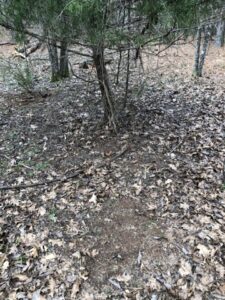
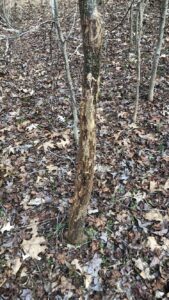
Photos 1 and 2. White-tailed deer scrape and rub observed on a recent small game hunt. Studying these signs after deer season can be extremely valuable for advancing a hunter’s understanding of how deer utilize a property during hunting season.
Wild pig hunting
This is also a great time to contribute to the noble cause of wild pig removal. Wild pigs are extremely destructive and have cascading negative impacts on native ecosystems. There is no closed season and no bag limit on private lands and, generally, for most public lands you can hunt pigs during stated game seasons using legal weaponry for the season. For example, I recently harvested a number of pigs on a wildlife management area for which small game shotgun ammunition is limited to shot shells 3.5 inches or smaller in length with No. 2 or smaller shot and rifles or handguns are limited to any 0.22 caliber or smaller rimfire, air rifle, or muzzleloader, which are sufficient to ethically and effectively harvest most pigs. Always be sure to review the Georgia Hunting Seasons and Regulations Guide (https://georgiawildlife.com/hunting/hunter-resources) to ensure that you are using legal methods. I encourage you to get out and do your part to help Georgia ecosystems by harvesting wild pigs!
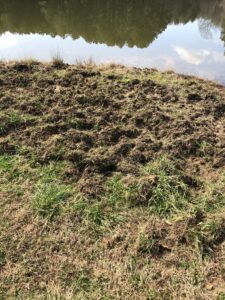
Photo 3. Wild pig damage observed on a recent small game hunt. Approximately ½ mile away, I found a group of 6 pigs (1 sow and 5 piglets) that were likely responsible for this damage and “removed the problem.”
Fishing
Although the weather during this time of year may not be deemed as preferred fishing weather for some, those cold and dreary days can produce some great fishing action and warmer days are soon to come! For the past few weeks, water temperature in the reservoir that I fish most frequently has been 47–52°F and I have been consistently catching numbers of crappie, striped bass, and hybrid striped bass in water 24–38 ft. deep. While the depth of suspension within this range varies depending on water clarity, time of day, and daily weather conditions, this depth range has been consistently holding fish. As the days lengthen and average daily temperature increases slightly over the next few weeks, look for water temperature to start climbing into the mid- to upper-50s and for the crappie to spend more time in the 18–22 ft. depth range. As the water temperature continues to climb, the crappie will continue to move closer to shore in anticipation of the spring spawn and it will be time to watch some slip corks disappear!
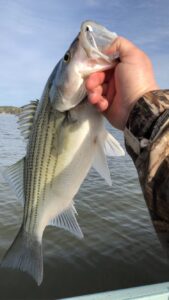
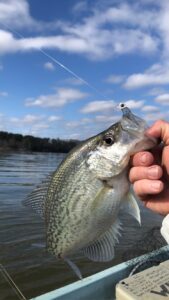
Photos 4 and 5. Some catches from some recent trips when the water and air temperatures were below 50°F.
Habitat Management
In addition to seasonally relevant hunting and fishing opportunities, now is a fantastic time to work on habitat management practices. The most commonly applied management tool for this time frame is prescribed fire. Land managers across the state are applying late-dormant season prescribed fire for a variety of forest management and habitat enhancement objectives including fuels reduction and general stand maintenance, increasing aesthetic qualities, and the promotion of native warm season grasses and other beneficial herbaceous vegetation. We are also approaching the early-growing season window when many prescribed fire practitioners will be using more intense fire to combat woody intrusion and competition in forest understories that are managed with a wildlife emphasis. While it is important to note that day of burn conditions and firing techniques play a major role in fire intensity, these are common scenarios for seasonal burn objectives and outcomes. In addition to the application of prescribed fire, late winter is an optimal time to perform light disking in areas that are managed focally for early succession habitat. Specifically, this winter disking influences vegetative community structure and species assemblages to promote a key selection of valuable herbaceous plants that contribute greatly to nesting and brood rearing habitat for upland game birds and provide protein-rich forage for white-tailed deer during lactation and antler growing periods. Further, this is also a great time to wrap up dormant season herbicide injections for forest stand improvement.
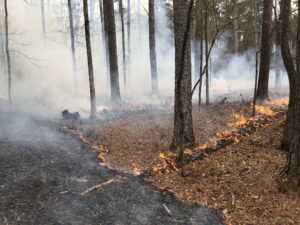
Photo 6. Action shot from a recent prescribed burn at GWF Headquarters.
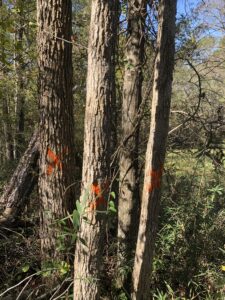
Photo 7. Three sweetgums (marked with and orange “x”) are crowding an oak at GWF Headquarters. Selective removal (via herbicide injection) of the sweetgums will allow the oak to increase height and diameter growth, increase canopy size, and, ultimately, increase mast production.
For more information on management practices to enhance wildlife habitat quality on your property and to schedule an AT-NO-COST site visit consultation, contact GWF Private Lands Biologist Evan Wheeler at evan@gwf.org or visit https://gwf.org/privatelands/.
The Georgia Wildlife Federation Private Lands Stewardship Program is supported by a grant from the National Fish and Wildlife Foundation’s Longleaf Stewardship Fund in partnership with Southern Company, USDA Natural Resources Conservation Service, and USDA Forest Service.
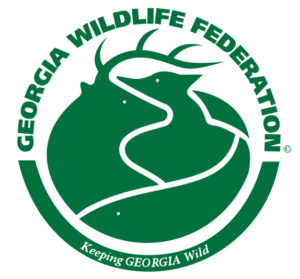
Recent Comments